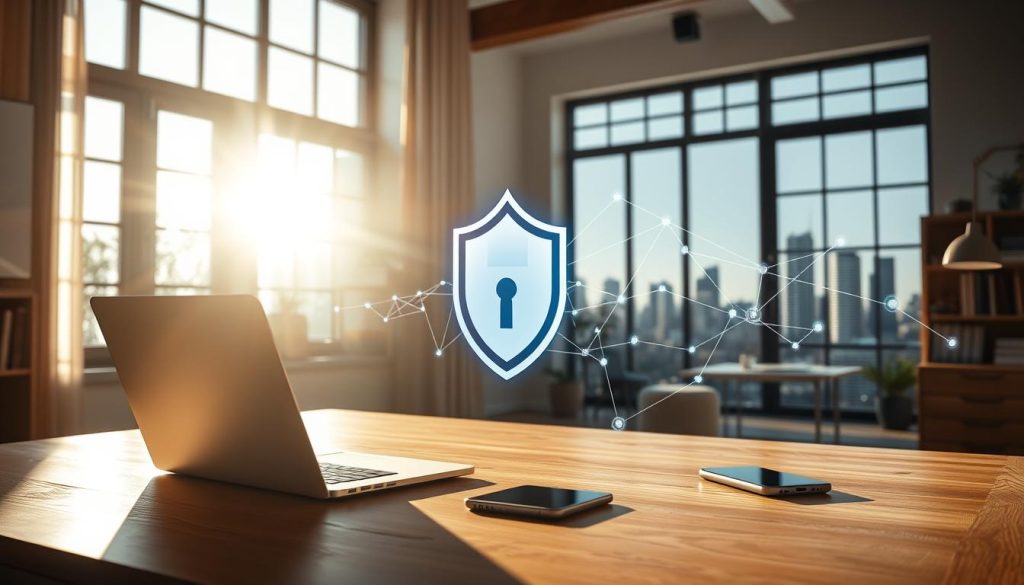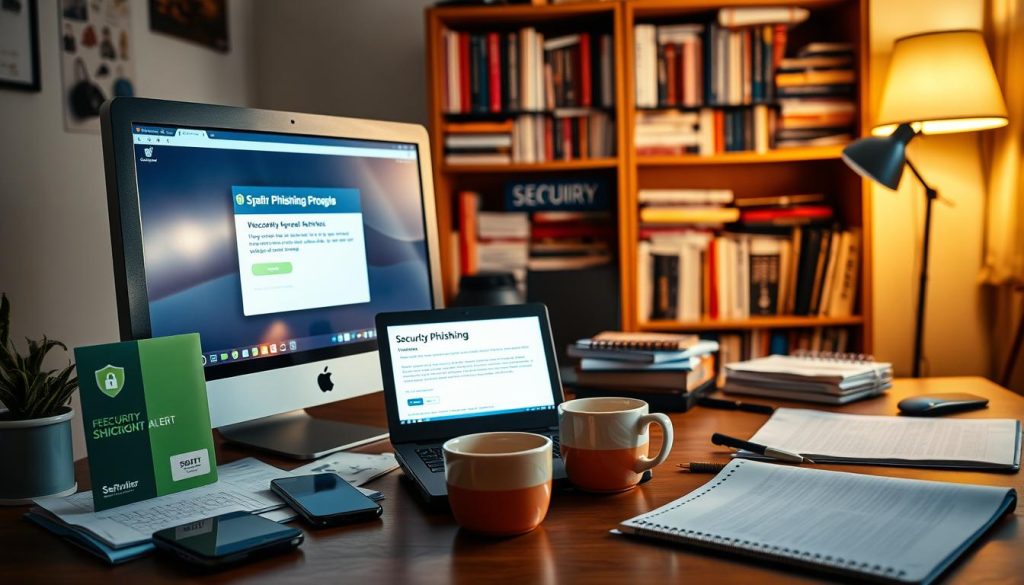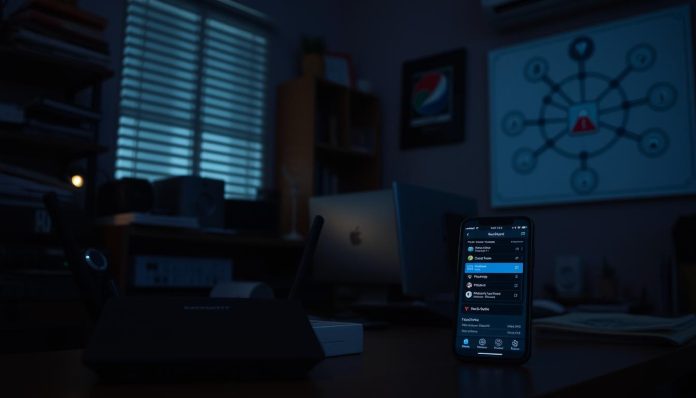Cybercriminals are now exploiting vulnerabilities in home networks to get to sensitive info. They use phishing, a trick to get people to share personal data.
So, you might ask how to protect your home network from these threats. First, learn about phishing attacks. They use emails, texts, and social media to trick people into sharing their info.
As a homeowner, knowing about these threats is key. By spotting phishing attempts, you can lower your risk of falling victim.
Key Takeaways
- Phishing is a highly effective form of cybercrime used to target home networks.
- Cybercriminals use multiple channels to launch phishing attacks.
- Understanding the signs of phishing is crucial to protecting your network.
- Proactive measures can significantly reduce the risk of phishing attacks.
- Home network security is a critical aspect of overall cybersecurity.
Understanding Phishing Attacks
As you explore the online world, knowing about phishing attacks is key to keeping your digital identity safe. Phishing tricks people into sharing sensitive info like login details or financial data. It can happen through emails, texts, or fake websites.
Definition of Phishing
Phishing is a cyberattack where scammers pretend to be trustworthy to get personal info from victims. They use fake messages that look like they’re from banks or big companies.
Common Types of Phishing
There are many phishing attacks, each with its own way of working. Email phishing is common, with scammers sending lots of emails. Spear phishing targets specific people or groups. Other types include vishing (voice phishing) and smishing (SMS phishing).
- Email Phishing: Mass emails sent to potential victims.
- Spear Phishing: Targeted phishing aimed at specific individuals or organizations.
- Vishing: Phishing conducted through voice calls.
- Smishing: Phishing via SMS or text messages.
Motivation Behind Phishing Attacks
Phishing attacks are often driven by a desire for money or data theft. Scammers might want to steal login info to get into bank accounts or use it for identity theft. Knowing why they do it can help you avoid falling for their tricks.
The Rise of Phishing Attacks on Home Networks
Home networks are now a major target for phishing attacks. This is a big concern for cybersecurity. With more people working from home, these networks are more vulnerable to attacks.
Cybercriminals find it easier to get into home networks than secure corporate ones. This has led to more phishing attacks aimed at home networks.
Statistics on Home Network Phishing
Phishing attacks on home networks are happening fast. A report shows a 65% increase in phishing attacks last year. Home networks are a big target.
| Year | Phishing Attacks on Home Networks | Percentage Increase |
|---|---|---|
| 2021 | 120,000 | – |
| 2022 | 200,000 | 66.7% |
The table shows a big jump in phishing attacks on home networks over two years.
Reasons for Targeting Home Networks
Why are cybercriminals going after home networks? They are easier to hack because home networks have weaker security. Many homeowners don’t update their router or use strong passwords.
Common vulnerabilities include:
- Outdated router firmware
- Weak passwords
- Lack of firewall protection
Knowing these weaknesses helps homeowners improve their cybersecurity. This can help fight off phishing attacks.
Identifying Phishing Attempts
Phishing attempts are getting smarter, so it’s key to know how to spot them. Cybercriminals use many tricks to fool people. But, there are signs that can help you see if you’re being phished.
Common Signs of a Phishing Email
Phishing emails often try to rush you into giving out personal info. They usually have urgent calls to action. Also, look for spelling and grammar mistakes. Real companies usually write better emails.
- Mismatched or suspicious email domains
- Generic greetings instead of personalized ones
- Suspicious links or attachments
It’s important to be careful with links and attachments. Always check where a link goes before you click on it.
Red Flags in SMS Phishing
SMS phishing, or smishing, uses fake texts to get your personal info. Be cautious of messages that try to scare or rush you.
- Messages asking for sensitive information
- Links to suspicious websites
- Poor grammar and spelling
Spotting Phishing Websites
Phishing websites look like real ones, making them hard to tell apart. But, there are key indicators to look for.
- URLs that are slightly different from the legitimate site
- Lack of HTTPS encryption
- Poor design and functionality
Always check the URL and look for HTTPS encryption before you give out any sensitive info.
The Dangers of Phishing Attacks
Phishing attacks are a big threat. They can cause financial loss, steal personal data, and harm digital security. These attacks can hurt both individuals and organizations.

Financial Losses
Phishing attacks can lead to financial loss right away. Hackers can get into bank accounts and credit cards. This can cause big money losses.
Key financial risks include:
- Direct theft from bank accounts
- Unauthorized purchases
- Credit card fraud
Privacy Breaches
Phishing attacks often lead to privacy breaches. Sensitive personal info like emails and personal identifiers can be stolen.
The consequences of privacy breaches can be severe. They can lead to identity theft and harm your reputation.
Impact on Your Digital Security
Phishing attacks can also hurt your digital security. Hackers can install malware or ransomware. This can make your digital space unsafe.
To mitigate these risks, you need strong security. This includes:
- Regularly updating your antivirus software
- Using strong, unique passwords
- Employing two-factor authentication
By knowing the dangers of phishing and blocking them, you can protect your digital space. This keeps your personal and financial info safe.
Protecting Your Home Network
Smart home devices have made securing your home network more important than ever. Your home network connects all your devices and lets them talk to each other. It’s key to keep it safe from hackers and cyber threats.
Importance of Strong Passwords
Strong, unique passwords are a must for your network and devices. Weak passwords can be guessed by hackers, letting them into your network. A good password mixes letters, numbers, and special characters.
Change your passwords often and don’t use the same one everywhere. This helps prevent a single hack from ruining your whole digital life.
Updating Router Firmware
Keeping your router’s firmware updated is crucial for network security. Updates patch security holes found since the last update. Manufacturers release these updates to fight new threats.
To update your router, log into its admin panel through a web browser. Look for updates and turn on auto-updates to stay protected.
Using Firewall and Antivirus Solutions
Firewalls and antivirus software are key to network protection. Firewalls block unwanted internet traffic and let in only what’s safe. Antivirus software finds and removes malware from your devices.
| Security Measure | Description | Benefits |
|---|---|---|
| Firewall | Controls incoming and outgoing network traffic | Blocks unauthorized access, reduces risk of hacking |
| Antivirus Software | Scans for malware and malicious software | Protects against viruses, Trojans, and other malware |
| Strong Passwords | Unique passwords for network and devices | Prevents unauthorized access, protects personal data |
By using these security steps, you make your home network much safer. This protects your personal data and keeps your browsing safe.
Recognizing Social Engineering Techniques
To keep your personal data safe, it’s key to know the tricks cybercriminals use. Social engineering tricks people into sharing sensitive info. It plays on human psychology, not just tech weaknesses.
Understanding Deceptive Tactics
Cybercriminals use many tricks to fool their victims. Some common ones are:
- Creating a sense of urgency to prompt immediate action
- Using fake emails or messages that appear to be from legitimate sources
- Exploiting emotions such as fear or greed
Knowing these tricks can help you dodge phishing scams. Always be on guard and check any odd or suspicious messages.
Trust Exploitation in Phishing
Trust is a big part of social engineering. Attackers pretend to be trusted, like banks or government agencies, to win your trust. To stay safe:
- Check if requests for sensitive info are real
- Be careful of messages you didn’t ask for
- Use two-factor authentication whenever you can

Implementing Email Security Measures
Phishing attacks are getting smarter, so it’s crucial to boost your email security. Knowing how to spot and stop phishing emails is key.
Using Spam Filters
Spam filters are a strong defense against phishing emails. They can catch suspicious emails before they reach you. Make sure to update your spam filter regularly to keep it effective.
Employing Domain Authentication
Domain authentication tools like SPF, DKIM, and DMARC check if emails are real. Using these tools can lower the chance of phishing emails getting to your inbox.
Training for Phishing Awareness
Learning to spot phishing attempts is essential. This means knowing common tricks, being careful with links and attachments, and how to report suspicious emails. Regular training helps a lot in recognizing phishing emails.
By using spam filters, domain authentication, and training, you can greatly improve your email security. This will help protect you from phishing attacks.
Safe Browsing Practices
As you explore the digital world, it’s key to follow safe browsing practices to shield your home network from phishing. Safe browsing habits can greatly lower the chance of falling prey to cyber threats.
To keep your online activities safe, consider these important strategies:
Checking Website URLs
One easy yet powerful way to dodge phishing is by double-checking website URLs. Watch out for sites with typos or odd characters, as they might look like real sites but aren’t.
- Make sure the URL starts with “https” and look for the padlock icon in the address bar.
- Be cautious of URLs with typos or slight changes to real site names.

Avoiding Suspicious Links
Steering clear of suspicious links is another vital part of safe browsing. Phishing scams often use tempting or scary links to get users to share sensitive info.
- Hover over links to see where they lead before clicking.
- Don’t click on links from emails or messages you didn’t ask for.
Utilizing HTTPS Protocol
The HTTPS protocol is a must for a secure web experience. It encrypts data between your browser and the site, making it tough for hackers to get your info.
Make sure any site you visit, especially those that need your login, uses HTTPS. Check for the “https” prefix and the padlock icon in your browser’s address bar to confirm it’s secure.
By following these safe browsing practices, you can greatly boost your online safety and protect your home network from phishing attacks.
Utilizing Two-Factor Authentication
Cyber threats are getting more common. Using two-factor authentication is key to protecting your home network. This extra security step helps keep your personal info safe from unauthorized access.
Overview of Two-Factor Authentication
Two-factor authentication (2FA) asks for two different things to get into an account. You might need a password, a phone, or a fingerprint. This makes it tough for hackers to get in.
2FA has many benefits:
- Enhanced Security: It adds a layer of protection, making it hard for hackers to get into your accounts.
- Reduced Phishing Success: Even if hackers get your password, 2FA stops them from getting in further.
- Compliance and Best Practices: Many places now say 2FA is a must for keeping info safe.
Setting Up Two-Factor Authentication
Setting up 2FA is easy and quick:
- Choose Your 2FA Method: You can use SMS codes, apps like Google Authenticator, or biometrics.
- Enable 2FA on Your Accounts: Most online services let you turn on 2FA. Just check your settings.
- Store Backup Codes Securely: Services give you backup codes. Keep them safe, like in a password manager.
Using two-factor authentication makes your online security much stronger. It keeps hackers out of your accounts.
What to Do After a Phishing Attempt
If you’ve recently faced a phishing attempt, acting fast is key to protect your data. Phishing can cause big problems with your money and privacy if not handled quickly.
Steps to Follow if You Clicked a Link
If you clicked on a suspicious link, the first thing to do is disconnect from the internet. This stops more harm. Then, change your passwords for important accounts like email and banking right away.
Key actions to take:
- Disconnect from the internet
- Change passwords for all sensitive accounts
- Run a full antivirus scan on your device

Reporting Phishing Attempts
Telling authorities about phishing is important to catch cybercriminals. Report the incident to the right places and the company being tricked.
Reporting channels:
| Organization | Reporting Method |
|---|---|
| Federal Trade Commission (FTC) | File a complaint at ftc.gov/complaint |
| Anti-Phishing Working Group (APWG) | Report phishing at apwg.org/report-phishing |
| Your email provider | Mark the email as phishing/junk |
Monitoring Your Accounts for Fraudulent Activity
After a phishing attempt, watch your accounts for anything odd. Check your bank statements and credit reports for any unauthorized activity.
Monitoring tips:
- Set up alerts for unusual transactions
- Regularly review account statements
- Use credit monitoring services
The Role of Internet Service Providers
Internet Service Providers play a huge role in fighting phishing. They are key to keeping your home network safe. ISPs use many ways to shield their customers from phishing scams.
How ISPs Combat Phishing
ISPs use several methods to fight phishing, including:
- Monitoring network traffic for suspicious activity
- Implementing security protocols to block phishing sites
- Providing customers with tools and resources to identify and report phishing attempts
Key Measures by ISPs:
| Measure | Description | Benefit |
|---|---|---|
| Network Monitoring | Continuous monitoring of network traffic | Early detection of phishing attempts |
| Security Protocols | Implementation of security measures to block phishing sites | Prevention of access to malicious sites |
| Customer Education | Providing resources to identify and report phishing | Empowering customers to take action against phishing |
Reporting Phishing to Your ISP
If you think you’ve been hit by a phishing scam, tell your ISP right away. Most ISPs have special ways to report these issues. You can use email, phone, or online forms.
Reporting phishing helps you and helps fight phishing for everyone on your ISP’s network. It’s a big step in keeping the internet safe.
Staying Informed About New Threats
The world of cybersecurity threats is always changing. It’s important to stay alert and know what’s new. This helps keep your home network safe from threats.
Following Cybersecurity News
To stay ahead, follow trusted cybersecurity news sites. CyberScoop and Dark Reading are great sources. They offer the latest on threats and how to fight them. You can also get updates by subscribing to their newsletters or following them on social media.
Many blogs and forums talk about new threats and how to avoid them. Being part of these groups helps you learn and share. You get to hear from others who have faced similar challenges.
Joining Online Security Communities
Getting involved in online security groups is a smart move. Sites like Reddit’s r/netsec and Stack Exchange are full of useful info. These places talk about new security issues, share tips, and support each other.
| Community | Description | Benefits |
|---|---|---|
| Reddit’s r/netsec | A subreddit dedicated to network security discussions. | Stay updated on the latest security news and threats. |
| Stack Exchange Cybersecurity | A Q&A platform for cybersecurity professionals and enthusiasts. | Access a wealth of information on various cybersecurity topics. |
| Cybersecurity Forums | Various online forums focused on cybersecurity. | Engage with a community to learn from others’ experiences. |
By keeping up with these sources, you can protect your home network better. It’s a way to stay safe online and help others do the same. It’s a win-win for everyone.
Future Trends in Phishing Attacks
It’s key to know about future phishing trends to boost cybersecurity. As tech grows, so do hackers’ methods. This part will look at how hackers change their ways and how new tech affects phishing.
Evolving Tactics of Cybercriminals
Hackers keep finding new ways to get past security. Some new methods include:
- Personalized Phishing: They’re making emails seem more real, making it tough to tell fake from real.
- AI-Powered Phishing: They’re using AI to make fake emails look better and to attack more often.
- Social Engineering: They trick people into sharing secrets with them using mind games.
These new tricks show we need better security and to teach people how to stay safe.
Influence of New Technologies
New tech is helping hackers make phishing attacks better. Some big impacts are:
- The Internet of Things (IoT): More IoT devices mean more chances for hackers to find weak spots.
- Cloud Services: Cloud use is growing, making it a new target for phishing.
- Mobile Technology: With more people using phones, phishing attacks are moving to mobile too.
Knowing about these tech impacts helps us find ways to stop phishing attacks.
To keep up with these trends, we need strong security steps. This includes keeping software up to date, training employees, and using top-notch threat detection tools.
Conclusion: Staying Vigilant Against Phishing
Phishing attacks on home networks are a big threat to your online safety. To stay safe, you need to keep working hard and stay alert. This helps protect your home network from these dangers.
Key Strategies for Protection
To keep your home network safe, use strong passwords and update your router regularly. Also, make sure to use firewalls and antivirus software. These steps can greatly lower the chance of falling prey to phishing.
Maintaining Online Safety
Keeping your online safety up is a continuous job. Always stay updated on new threats and follow the best online security practices. This way, you can better defend your home network and stay safe from phishing attacks.

